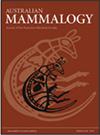Geometric differences between the crania of Australian hopping mice (Notomys, Murinae, Rodentia)
IF 1.2
4区 生物学
Q3 ZOOLOGY
引用次数: 5
Abstract
Half of the ten Australian hopping mice (Notomys) species have become extinct following the European colonisation of Australia, and most of the rest are threatened. This makes the study of their present diversity paramount. Although recent molecular phylogenies improved our understanding of the relationships among the species, detailed interspecific phenotypic comparisons are still lacking. This is the aim of the present study. Geometric morphometric methods were used to compare the crania of all five extant species (N. alexis, N. aquillo, N. cervinus, N. fuscus, and N. mitchellii) along with the extinct N. longicaudatus. Although previous work (based on traditional approaches) find intragenerically conserved crania, the present study discovers significant differences in cranial size and shape among Notomys species, with the ventral view being more distinct than the dorsal view. There was no evidence of sexual dimorphism in cranial size nor shape, and only a weak allometric effect. Most aspects of cranial shape differed among the species. The extant species pair that differed in cranial shape the most was N. aquilo – N. cervinus, differing in the foramen magnum, tympanic bulla, orbit, incisive foramen, and rostrum, along with cranial width, potentially a consequence of N. cervinus’ phylogenetic position, and N. aquilo’s s ecological uniqueness.澳洲跳鼠(Notomys, Murinae, Rodentia)颅骨的几何差异
在欧洲对澳大利亚进行殖民统治后,澳大利亚十种跳鼠中有一半已经灭绝,其余大部分都受到了威胁。这使得研究它们目前的多样性变得至关重要。尽管最近的分子系统发育提高了我们对物种之间关系的理解,但仍然缺乏详细的种间表型比较。这就是本研究的目的。几何形态计量方法用于比较所有五个现存物种(N.alexis、N.aqillo、N.cervinus、N.fuscus和N.mitchellii)以及已灭绝的长尾猪笼草的头骨。尽管之前的工作(基于传统方法)发现了属内保守的颅骨,但本研究发现,Notomys物种的颅骨大小和形状存在显著差异,腹侧视图比背侧视图更明显。没有证据表明颅骨大小和形状存在两性异形,只有微弱的异速生长效应。头骨形状的大部分方面因物种而异。现存的颅骨形状差异最大的物种对是N.aquilo–N.cervinus,其大孔、鼓泡、眶、尖孔和喙孔以及颅骨宽度都不同,这可能是N.cervins的系统发育位置和N.aquillo的生态独特性的结果。
本文章由计算机程序翻译,如有差异,请以英文原文为准。
求助全文
约1分钟内获得全文
求助全文
来源期刊

Australian Mammalogy
ZOOLOGY-
CiteScore
2.50
自引率
8.30%
发文量
26
期刊介绍:
Australian Mammalogy is a major journal for the publication of research in all branches of mammalogy. The journal’s emphasis is on studies relating to Australasian mammals, both native and introduced, and includes marine mammals in the Antarctic region. Subject areas include, but are not limited to: anatomy, behaviour, developmental biology, ecology, evolution, genetics, molecular biology, parasites and diseases of mammals, physiology, reproductive biology, systematics and taxonomy.
Australian Mammalogy is for professional mammalogists, research scientists, resource managers, consulting ecologists, students and amateurs interested in any aspects of the biology and management of mammals.
Australian Mammalogy began publication in 1972 and is published on behalf of the Australian Mammal Society.
 求助内容:
求助内容: 应助结果提醒方式:
应助结果提醒方式:


